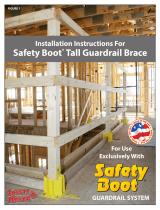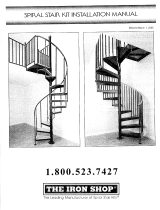Page is loading ...

Vestil Manufacturing Corporation
2999 North Wayne St., Angola, IN 46703
Ph: 260-665-7586 • Fax: 260-665-1339
E-mail: [email protected]
Website: www.vestil.com
Contents
ALTERNATING-TREAD STAIR • Series ATS
OWNER'S
MANUAL
Revised 0107
A company dedicated to solving ergonomic
and material handling problems since 1955.
RECEIVING INSTRUCTIONS
Every unit is thoroughly tested and inspected prior to
shipment. However, it is possible that the unit may incur damage
during transit. If damage is noticed when unloading, make a note
of it on the BILL OF LADING. Remove all packing and strapping
material, then inspect the unit again for damage. IF DAMAGE IS
EVIDENT, FILE A CLAIM WITH THE CARRIER
IMMEDIATELY!
WARRANTY
This product is warranted for 90 DAYS from date of purchase to
be free of manufacturing defects in material and workmanship.
This warranty does not cover normal wear of parts or
damage resulting from any of the following: negligent use or
misuse of the product, a use or application contrary to
installation instructions, or the disassembly, repair or alteration
by any person prior to authorization from a factory
representative.
Receiving Instructions .......................................... 1
Warranty ............................................................... 1
Specification Chart ............................................... 1
Specification Drawing ...........................................2
Assembly/Installation Instructions .........................3
Model
Number
ATS-4-56
ATS-5-56
ATS-6-56
ATS-7-56
ATS-8-56
ATS-9-56
ATS-10-56
ATS-4-68
ATS-5-68
ATS-6-68
ATS-7-68
ATS-8-68
ATS-9-68
ATS-10-68
Number
of Steps
7
8
10
12
13
15
16
6
7
9
10
11
13
14
Length
(B)
36-5/8"
44-11/16"
52-13/16"
60-7/8"
69"
77-1/16"
85-3/16"
26"
30-13/16"
35-11/16"
40-9/16"
45-3/8"
50-1/4"
55-1/16"
Height
(A)
48"
60"
72"
84"
96"
108"
120"
48"
60"
72"
84"
96"
108"
120"
Step Height
(C)
6-7/8"
7-1/2"
7-3/16"
7"
7-3/8"
7-3/16"
7-1/2"
6-7/8"
7-1/2"
7-3/16"
7"
7-3/8"
7-3/16"
7-1/2"
Angle
(D)
56°
56°
56°
56°
56°
56°
56°
68°
68°
68°
68°
68°
68°
68°
Handrail
Height (E)
17-3/16"
17-3/16"
17-3/16"
17-3/16"
17-3/16"
17-3/16"
17-3/16"
10-13/16"
10-13/16"
10-13/16"
10-13/16"
10-13/16"
10-13/16"
10-13/16"
Usable Step
Length (F)
9-1/4"
10-1/8"
9-11/16"
9-7/16"
9-15/16"
9-11/16"
10-1/8"
5-9/16"
6-1/16"
5-13/16"
5-11/16"
5-15/16"
5-13/16"
6-1/16"
Bottom Handrail
Height (G)
27-1/2"
27-1/2"
27-1/2"
27-1/2"
27-1/2"
27-1/2"
27-1/2"
34"
34"
34"
34"
34"
34"
34"
SPECIFICATIONS (for Drawing on Back)
ALTERNATING-TREAD STAIR
Series ATS
E
N
G
L
I
S
H
E
S
P
A
N
O
L
F
R
A
N
Ç
A
I
S

SPECIFICATION DRAWING

ASSEMBLY / INSTALLATION INSTRUCTIONS
Review this entire page before installing the stair. Consult
the factory in the event there are any questions or
problems at the time of installation.
¨ The alternating-tread stair is intended for
installations requiring a stair having an angle of
inclination of 56° to 68° to the horizon. It has a
maximum load capacity of 300 pounds.
• Modifications to the stair without prior
manufacturer's authorization may void the
stair's warranty.
• The stair must be appropriately
anchored at the top and bottom
before use.
• The installation must be made so that
it complies with all the building
regulations applicable to the location.
The end-user must verify that the
stair is installed so it will be suited for
the application in which it will be
used.
• Installation must be performed by
suitably trained personnel with
access to the appropriate equipment.
TOOLS FOR INSTALLATION:
1. A fork truck or hoisting means to
unload the lift from the freight truck. It
will also be advantageous to have the
lifting device to help set the stair into
place.
2. Tools and hardware appropriate for
the selected method of installation.
Consult the building's architect or
facility engineer to determine the best
type of hardware with which to anchor
the stair.
ASSEMBLY:
1. Turn the stair on its side.
2. Secure the lower handrail (consult the included assembly drawing for identification of the handrails) to the lower end of the tread
runner using a 1/2" flat washer, lock washer, and bolt.
3. Slide the upper handrail onto the lower handrail.
4. Secure the end of the upper handrail and its support bracket using 1/2" flat washers, lock washers, and bolts.
5. Turn the unit on the opposite side and repeat steps 2 - 4.
INSTALLATION:
1. Stand the stair upright, with the highest step resting against the side of, and the top step even with, the upper floor level.
2. Attach the top of the stair by installing appropriate hardware through the hole and slot located in the edge of the top step.
3.
Warning!
Do not stand on the stair until the installation is complete.
4. Attach the bottom of the stair to the lower floor level using appropriate hardware through the slots in the base channel.
5. Align the bottom and top ends of the stairs so the stair is perpendicular to the wall it is being mounted against, and tighten all
hardware wrench-tight.
6. There are snap hooks on the ends of each of the two included safety chains. Attach one end of each chain to a d-ring on one of
the upper handrail's vertical posts. Attach the other end of each chain to a d-ring on the opposite post. Keep the chains secured
across the top stair opening when the stairs is not being used.
Periodically check that all the stair fasteners are maintained wrench tight.
/



